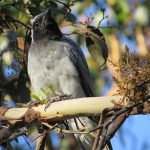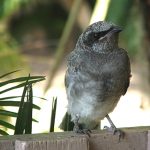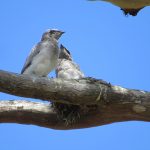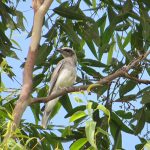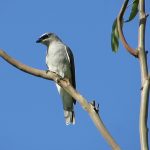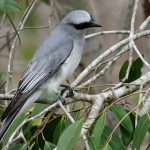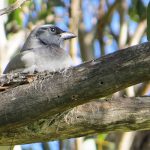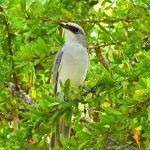CUCKOO-SHRIKES
Australian Cuckoo-shrikes are a group of bird species belonging to the family Campephagidae, commonly known as cuckoo-shrikes. These birds are found in various parts of Australia and are known for their graceful appearance and varied plumage.
Black-faced Cuckoo-shrike (Coracina novaehollandiae)has a distinctive black face mask and is one of the most common cuckoo-shrikes in Australia. Its plumage is mainly grey, and it has white underparts. Black-faced Cuckoo-shrikes are known for their loud and varied calls.
White-bellied Cuckoo-shrike (Coracina papuensis): As the name suggests, this species has a white belly, while the rest of its plumage is mostly black or dark grey. It has a prominent black eye stripe and white wing patches.
Barred Cuckoo-shrike (Coracina lineata): The Barred Cuckoo-shrike has a greyish-brown plumage with fine barring on its underparts, which gives it its name. It has a black cap and a distinctive call.
Ground Cuckoo-shrike (Coracina maxima): This species is the largest of the Australian Cuckoo-shrikes. It has a mainly grey plumage and is known for its habit of foraging on the ground, hence its name.
White-winged Triller (Lalage tricolor): While not a true cuckoo-shrike, the White-winged Triller is often associated with this family. It has a black and white plumage with a white wing patch, and it is commonly found in various habitats across Australia.
Australian Cuckoo-shrikes are insectivorous birds and are skilled at catching insects on the wing or gleaning them from vegetation. They often inhabit woodlands, forests, and open habitats, where they can be seen perched on branches, scanning for prey.
These birds are known for their varied vocalizations, which can include whistles, trills, and calls reminiscent of cuckoos, which is how they got their name. Some species also have beautiful and melodious songs.
For birdwatchers and nature enthusiasts, observing Australian Cuckoo-shrikes can be a rewarding experience due to their elegant appearance, captivating calls, and fascinating behaviors.
The Black-faced Cuckoo-shrike (Coracina novaehollandiae) is found in various parts of Australia.
It has a striking appearance with a black face mask that contrasts with its predominantly pale grey plumage. Its upperparts, including the wings and back, are mainly grey.The underparts are white, and there may be some variations in the intensity of grey on the belly and chest across different individuals. It has a long and slender bill, which is ideal for catching insects during flight.
The Black-faced Cuckoo-shrike is widespread across mainland Australia, including eastern, central, and northern parts of the country. It is commonly found in a range of habitats, including woodlands, forests, open savannah, and urban gardens.
Black-faced Cuckoo-shrikes are highly active birds that often forage in small flocks. They are insectivorous and primarily feed on insects, such as beetles, caterpillars, grasshoppers, and cicadas. They may also eat some fruits and berries. These cuckoo-shrikes are agile fliers and can catch insects on the wing or glean them from foliage.
The breeding season for Black-faced Cuckoo-shrikes typically occurs from September to January.
They build cup-shaped nests using twigs, grass, and other materials in the fork of a tree branch.
The female usually lays two or three eggs, and both parents share incubation and feeding duties for the chicks.
The Black-faced Cuckoo-shrike is known for its varied and melodious calls, which may include whistles, trills, and mimicry of other bird species. Their vocalizations can often be heard throughout the day, particularly during the breeding season.
Black-faced Cuckoo-shrikes are captivating birds to observe, and their unique appearance and vocalizations make them a favorite among birdwatchers and nature enthusiasts. If you have the opportunity to see one in the wild, you’re in for a delightful experience.
The White-bellied Cuckooshrike (Coracina papuensis) has a predominantly dark grey or black plumage with a white belly, and the contrast between the dark upperparts and white underparts is striking. It has a distinctive white patch on the wings, visible in flight. The species also has a black mask around its eye and a relatively long, hooked bill.
The White-bellied Cuckooshrike is found in northern and eastern parts of Australia, including Queensland, New South Wales, Northern Territory, and parts of Western Australia. It typically inhabits woodlands, open forests, and mangrove areas.
This cuckooshrike species is often observed in pairs or small family groups. They are insectivorous birds, feeding on a variety of insects and other small invertebrates. They actively forage through foliage and branches in search of prey.
The breeding season for White-bellied Cuckooshrikes generally occurs during the spring and summer months. They build cup-shaped nests using twigs, bark, and other plant materials, often placed on horizontal branches. The female usually lays 2-3 eggs, and both parents share incubation and feeding duties for the chicks.
The White-bellied Cuckooshrike has a varied and melodious song consisting of whistles, trills, and other vocalizations.

